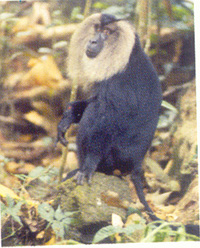 'I believe any trip in search of wildlife can be coupled with physical activity and elements of cultural diversity to form a thrilling opportunity '
'I believe any trip in search of wildlife can be coupled with physical activity and elements of cultural diversity to form a thrilling opportunity '
John H.Eickert
I had been walking a short while and there in a tree, just in front and above was a large dark creature licking the leaves from the tree it was sitting in. Such was my first encounter with the lion-tail macaque. I
was in Silent National Park walking the step shaped foothills of Kerala. Silent is in Kerala above the community of Perintalmanna or south from Ooty in Tamil Nadu in the Western Ghats. It is a very small park, part of a larger area. Most of the parks and some
of the land here belongs to an experimental area called the Nilgiri Biosphere Reserve.
What is unique is the desire to preserve the land and wildlife, and a way of life as well. Here indigenous subsistence living is encouraged and hopefully sustained. Indeed, the last hunter-gatherer group on the peninsula,
the Cholanaickens, lives here. With large corporate greed swirling unchecked and out of control across the face of our planet, I wish those people well and wish them much luck.
I also hope the Nilgiri Biosphere Reserve finds success, showing respect for the land, the wildlife, and the people who live there is an experiment contrary to life on our planet. I think it is a giant step forward.
In the tree, I think it was a fig tree, sat the dog sized black macaque with light colored facial hair and not surprisingly a long tail with a tuft of fur at the end, a lion tail! The tree was very tall, perhaps 50-55 meters. We were in a small dark forest
surrounded by grassland. Such forests in the Western Ghats are called sholas.  These sholas have always existed, but were enhanced by timber felling and fire from the hand of man. In our age, I can imagine this taking place, but timber-felling tens of thousands
of years ago could not have been that easy.
These sholas have always existed, but were enhanced by timber felling and fire from the hand of man. In our age, I can imagine this taking place, but timber-felling tens of thousands
of years ago could not have been that easy.
I heard an answer to this riddle actually I heard it twice. I was told that it is possible, if properly trained, to shout down a large tree. Really, shouting in the Silent Valley! I have no reason to doubt what is
possible, as I have witnessed so many things, which I probably would not have believed had I stayed home. During my walk in the forest I also saw a giant Indian pied hornbill wing across a stretch of grassland and watched a Malabar squirrel hustle along the
branch of a tree. This area of India is rich in wildlife including tigers and elephants. The Western Ghats region is a wet forest, but not a rainforest. In a rainforest, there is precipitation year round, while in the Western Ghats and Silent Valley the rain
is seasonally heavy. It rains enough to sustain the forest and its creatures during the drier periods. I long for more time in these rich forests and I hope to see you there.
Please, take the time to go and when you go take your time.
Cheers.
(Photograph of lion tailed macaque by Ajith Kumar, ENVIS)
P.S by Dr. Susan Sharma
You can check the location of Nilgiri by clicking on the link below.NILGIRI BIOSPHERE RESERVE
Visit
http://www.numbum.net or call NumBum Adventurers at 406-777-2228